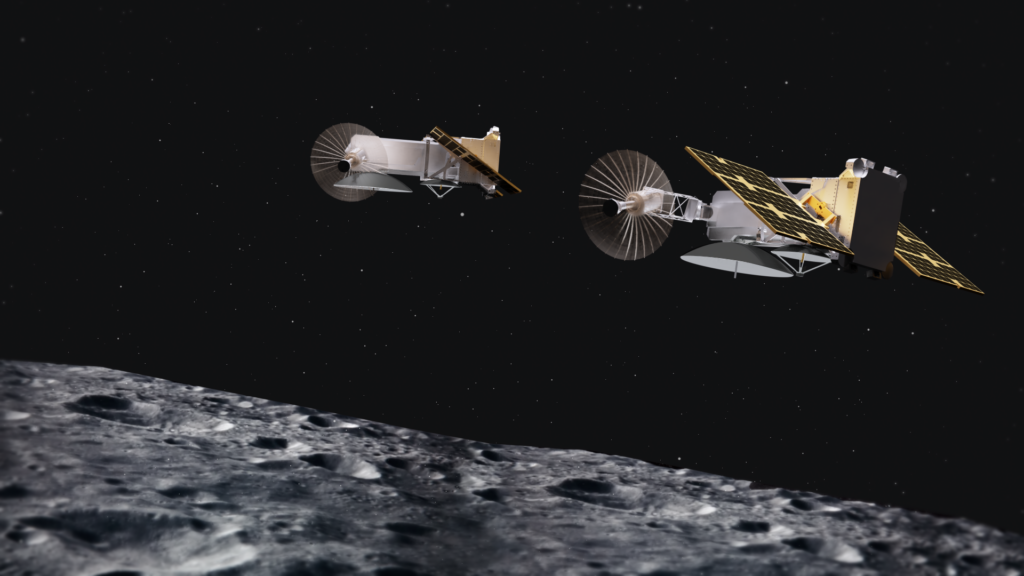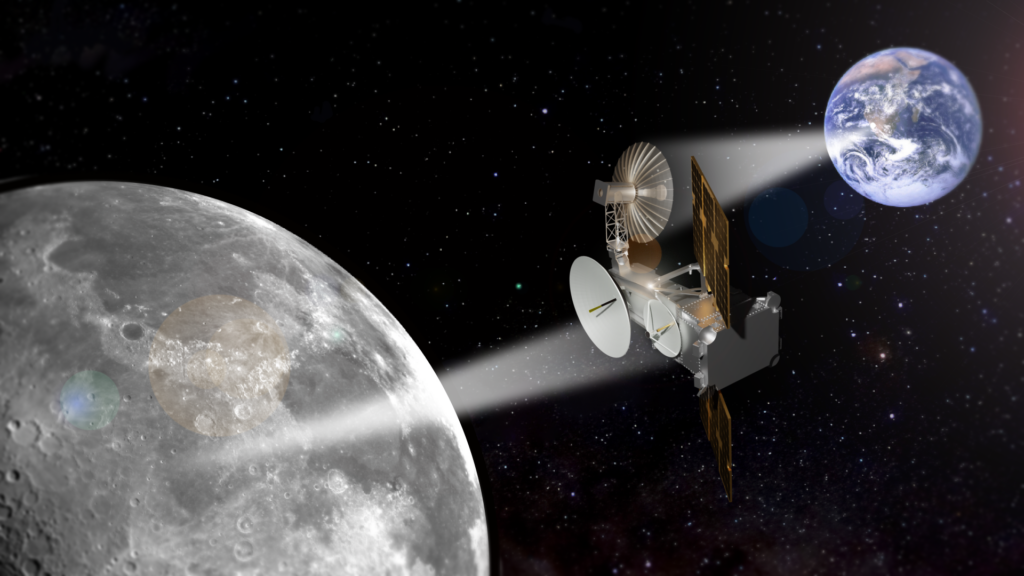
A computer-generated image of Alpine and Lupine.
Relay satellites are crucial to advancing the cislunar economy by facilitating communication and data transfer between Earth and lunar operations. Their strategic positioning enables continuous connectivity, which is essential for coordinating activities, monitoring resources, and supporting various missions on the lunar surface. As the cislunar economy grows, the reliability and efficiency provided by relay satellites will be vital to avoiding communications blackouts and ensuring seamless interactions among spacecraft, lunar bases, and mission control centers on Earth.
In September, ispace-U.S. introduced its Summit Mission Control Center (MCC), based in its U.S. headquarters in Denver, Colorado. Today at the 75th International Astronautical Congress (IAC), we are thrilled to introduce our relay satellites, Alpine and Lupine.
Alpine and Lupine pay homage to ispace-U.S.’s Colorado footing as the company’s headquarters is located at the foothills of the great Rocky Mountains. As the relay satellites operate in deep space, we can draw parallels between the harsh lunar environment and the rugged high alpine conditions in the mountains. Yet even in the unforgiving alpine terrain, vitality can be found in the form of alpine lakes and wildflowers such as the Lupine. Life finds a way to survive, and this resilience gives us courage as we search for water and other resources critical to sustaining future permanent human activities on the Moon.

A computer-generated image of the satellite.
Alpine and Lupine will be deployed into lunar orbit by the APEX 1.0 lunar lander prior to its landing. When the APEX 1.0 lunar lander touches down in Schrödinger Basin, a large impact crater on the lunar far side near the Moon’s South Pole, it will rely on Alpine and Lupine for communications to and from Earth. Alpine and Lupine will support the lander in its surface mission, which is designed to fulfill the Draper-led Commercial Lunar Payload Services Task Order (CP-12), delivering NASA payloads to the surface for scientific investigations. Blue Canyon Technologies, RTX’s small satellite manufacturer, will provide its Venus-100 bus platform for Alpine and Lupine. The two microsatellite buses will be deployed into lunar orbit.
Alpine and Lupine are equipped with bi-directional S-band command, telemetry links, and a high-speed Ka-band lunar proximity uplink and X-band downlink to Earth for low-latency real-time communications. After the primary surface mission, Alpine and Lupine are circularized into a high circular polar orbit (HCPO) with near-global coverage and linger points at the poles. For lunar South Pole landing sites, both relay satellites offer more than 70% simultaneous visibility of the lunar surface and Earth.
Additionally, beyond their primary missions for the NASA payloads, Alpine and Lupine offer a platform for other potential payloads, such as those pursuing alternative position, navigation, and timing (PNT), environmental monitoring, and cislunar space domain awareness (SDA) technology demonstrations. The manifest remains open for additional payloads on the APEX 1.0 lander and the relay satellites. The lunar far side will be in reach thanks to the communications and data transfer capabilities of Alpine and Lupine.
About ispace technologies U.S.
Ispace-U.S. is an American lunar exploration company providing transportation and infrastructure capabilities from Earth to lunar orbit and the surface of the Moon for government and commercial customers. ispace believes that the utilization of lunar resources is the catalyst for enabling human permanence and economic opportunity on and around the Moon and is committed to achieving this goal. The company’s U.S. headquarters serves as the central location for the development of its APEX 1.0 lunar lander, which is being designed, manufactured, and launched in the United States.
About Draper
Draper, as a nonprofit engineering innovation company, serves the nation’s interests and security needs; advances technologies at the intersection of government, academia and industry; cultivates the next generation of innovators; and solves the most complex challenges. Multidisciplinary teams drawn from a broad and deep talent pool of 1,600 engineers and scientists collaborate to develop first-of-a-kind solutions. Draper’s unbiased approach enables the company to focus on their customers’ needs and to deliver new capabilities to them. Learn more at draper.com.